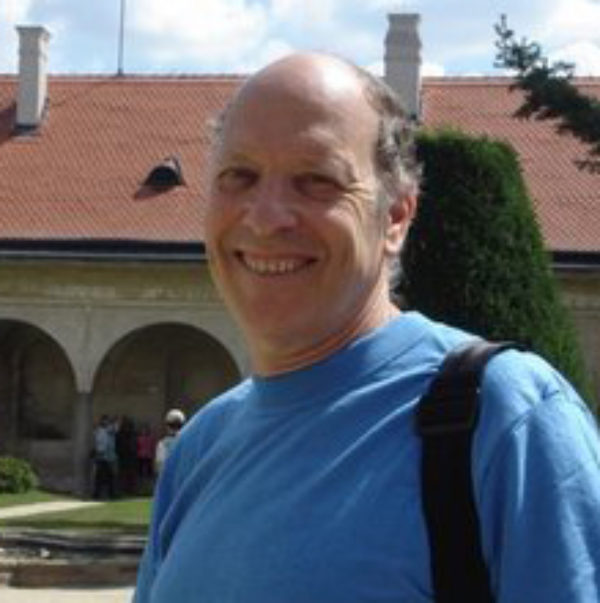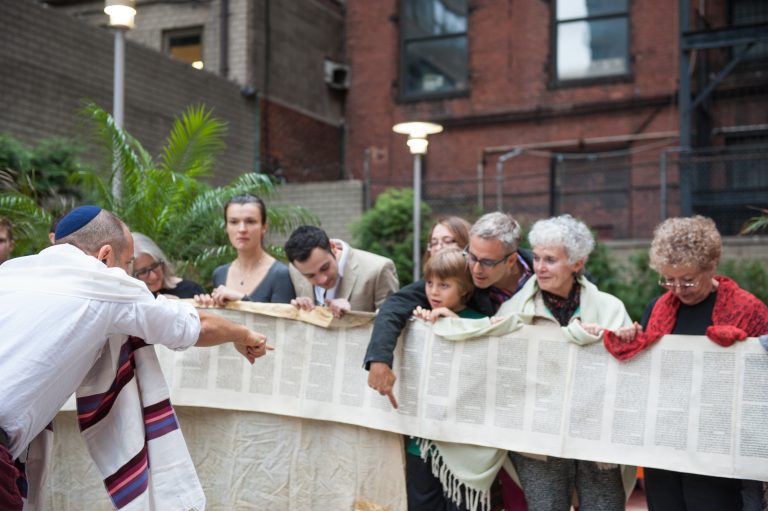
Image by Mo Riza.
Embedded in a Vanished World: The Legacy of Chassidic Folklore
“True, a story can put you to sleep, but it can also wake you up.”
—Rabbi Nachman of Breslov
From radios blaring up and down the block, I hear my father’s emphatic voice, shaking my shoulder. I’m late to school once again — and caught once again. I’m startled but proud.
My father’s radio program on the Yiddish station WEVD (originally named after the Socialist leader, Eugene V. Debs) was called Chassidim Dertzaylin, roughly translatable to “Chassidim Retell.” Back then in the early 1960s, Borough Park, Brooklyn was one of the more upscale neighborhoods of New York Jews — there were trees to be seen, even a few gardens — and, increasingly, Chassidim. Nearly all of these Chassidim were immigrants, survivors of the Holocaust, who wore distinctive clothing and spoke only Yiddish. Along with thousands of others, they were part of the avid audience who tuned in each week to hear the next installment of my father’s Chassidic stories.
My father, Rabbi Tovia Halberstam, was born and raised in Poland and came with his father to the United States as a young man. My grandfather was the first Chassidic Rebbe in Borough Park. A scion of Chassidic leaders on both his maternal and paternal sides, my father traced his unbroken lineage of rabbis back to the sixteenth century. While he, too, was ordained as a rabbi and commanded a wide mastery of traditional Jewish learning, he also read widely in non-Jewish literature and brought this extensive background to the Chassidic folktales he published in newspapers and told on the radio from the late 1940s to the 1960s.
The stories he retold had lived through oral transmission for generations. Unlike the more familiar Chassidic anecdotes and observations, these tales presented complex narratives, replete with robust and disparate personalities enriched by the dramatic arc of the literary short story. At the same time, they preserved the religious sensitivity and folkloric qualities of the venerable Chassidic legend. As do all legends that withstand the test of generations, their charms and insights are universal.
When several years ago my mother moved from her home of 50 years, I found a box with more than 200 of the stories my father — who’d died some 15 years previously — had typed out in Yiddish and from which he read on his radio program. I decided to translate these wonderful tales. I thought I’d do this in his honor, as a remittance, an appreciation. It turned out to be an enormous gift to myself.
Storytelling has always been integral to Chassidism, the mystical movement that began in the early eighteenth century and swept across Eastern European Jewish communities over the following two centuries. As folktale scholar Gedalyah Nigal notes:
“No religious movement in the entire course of Jewish history has engaged so intensively in storytelling as Hasidism; nor have stories occupied such a central and important place in any other intellectual movement within Judaism.”
The founder of Chassidism, Rabbi Eliezer ben Israel (1698–1760), the Ba’al Shem Tov, regularly regaled alienated Jews — the unlearned, women, children, and suspicious scholars, too — with his captivating tales. Thus, from its inception, storytelling became a pivotal means by which the movement gained followers. These stories, which focused on tzaddikim, the Chassidic masters, as well as the piety of simple men and women, emphasized the vitality of community, the majesty of music, and the importance of serving God through joy rather than asceticism. Typically, the stories dealt with the quotidian demands of everyday life: poverty and livelihood, matchmaking and divorce, illness and recovery, along with the spiritual concerns of sin and repentance, and reward and punishment in the afterlife.
In some stories, the Chassidic tzaddik resolves a problem through his mystical prowess. In others, he finds a solution through his discerning judgment and psychological intuition. Many tales illustrate the workings of “practical Kabbalah,” the Chassidic insistence on eliciting the sparks of “divine holiness” that permeate the universe. As one Chassidic Master put it:
“Kabbalah aims to bring the earth up to heaven; Chassidism aims to bring heaven down to earth.”
But the centrality of the story in Chassidism goes beyond pedagogy. For Chassidim, storytelling is itself a sacred performance. One morning, the Rebbe of Rhyzin was recounting stories to his Chassidic followers, when a disciple reminded him it was time for morning prayers. He replied, “And what do you think we’ve been doing!” Chassidim teaches that a properly told tale is akin to prayer for both the teller and the listener.
To be sure, translating these Chassidic Yiddish stories into contemporary English presented a formidable challenge. Prior to World War II, Yiddish was the lingua franca of eleven million people, with more native speakers than, say, Greek, Hungarian, Swedish, Dutch, or Czech. But the steady process of assimilation into mainstream American culture meant a dwindling number of Yiddish speakers. And the devastation of the Shoah ensured there’d be no further significant influx of additional Yiddish speakers.
Moreover, because these Chassidic tales were embedded in a vanished world, translation would involve more than finding linguistic equivalencies, of simply substituting an appropriate English word or phrase for a Yiddish one. As Irving Howe and Eliezer Greenberg write in the introduction to their Treasury of Yiddish Stories:
“In translating from French {say}, a certain community between French and English culture can safely be assumed, while in translating from Yiddish it is necessary not only to present a rough facsimile of a verbal sequence, but somehow to summon a world that exists beneath the words. Inevitably, though at great risk, the translator becomes a tacit social historian.”
What is true of Yiddish in general is especially true of the distinctive lifestyle and sensibilities of Chassidim. While my father could still assume his audience’s intimacy with the customs, calendar, cadences, and general social context of Eastern European Jewry, my audience would be bereft of such connections. But I also was sure the humor and sagacity of these tales would successfully cross these cultural borders.
Today, Chassidism is the fastest growing segment of Jewry the world over. This post-Holocaust development is truly astounding and unexpected. And, still, the Chassidic tale remains the best entry into the teachings and daily life of Chassidism. No doubt, my father would have been utterly astonished that I’d receive an NEA grant for the translation of these tales from “the old country.” I’d like to believe he’d be truly pleased — and I hope proud — by the collection of these stories in my book The Blind Angel: New Old Chassidic Tales. I do know he’d have been delighted if they help introduce the Chassidic story to a new, inquisitive audience.
I also know how nourished I’ve been by translating these tales. Though no longer belonging to the Chassidic world in which I was raised, neither sartorially nor behaviorally, by immersing myself once more in these stories, I’ve grown to cherish even more the legacy bequeathed to me, the rich rewards of these legends and the enduring Chassidic tradition whose story they tell.

